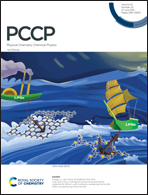Structural modulation of phenothiazine and coumarin based derivatives for high performance dye sensitized solar cells: a theoretical study†
Abstract
A series of dyes with the D–π–A architecture has been designed and studied for dye sensitized solar cells (DSSCs). We have used phenothiazine (PTZ) and coumarin (COU) derivatives as the donor unit and benzopyrrole (BTZ) and 2-methyl-2H-isoindole-1,3-(3aH,7aH)-diene (IND) as the acceptor unit along with the azomethine group and thiophene ring as the π-spacer unit. Three electron donating groups viz. –CH3, –NH2, and –OH and four electron withdrawing groups viz. –CF3, –COCl, –F and –NO2 have been attached at the donor and the acceptor units respectively of the four unsubstituted dyes COU–BTZ, PTZ–BTZ, COU–IND and PTZ–IND. Density functional theory (DFT) and time-dependent density functional theory (TD-DFT) methods have been employed to investigate the structural, electronic and photochemical properties of these dyes. The study reveals that the unsubstituted dye PTZ–BTZ possesses the lowest value of ΔH–L. Our study also reveals that attachment of the –NO2 group at the acceptor unit lowers the ΔH–L values of all the dye molecules. We have observed that the excited state oxidation potential (ESOP) of all the dyes lies above the conduction band of the TiO2 semiconducting surface. However, the ground state oxidation potential (GSOP) of most of the dyes belonging to the COU–BTZ and COU–IND groups lies below the redox potential of the I−/I3− redox couple. The total reorganization energy (λtot) values of the COU–BTZ and COU–IND groups of dyes are observed to be low compared to the other groups of dyes. The study of the charge transport properties of the dyes confirms that the designed dyes will act as electron transport materials. The absorption properties of the dyes show that the COU–BTZ group of dyes possesses the maximum values of the absorption wavelength (λmax values) and attaching the –NO2 group at the acceptor unit shifts the λmax values of all the dyes to the longer region. From the study of the electronic properties of the dye–TiO2 complexes it has been observed that the performance of the dyes has been enhanced compared to the isolated dye molecules.



 Please wait while we load your content...
Please wait while we load your content...